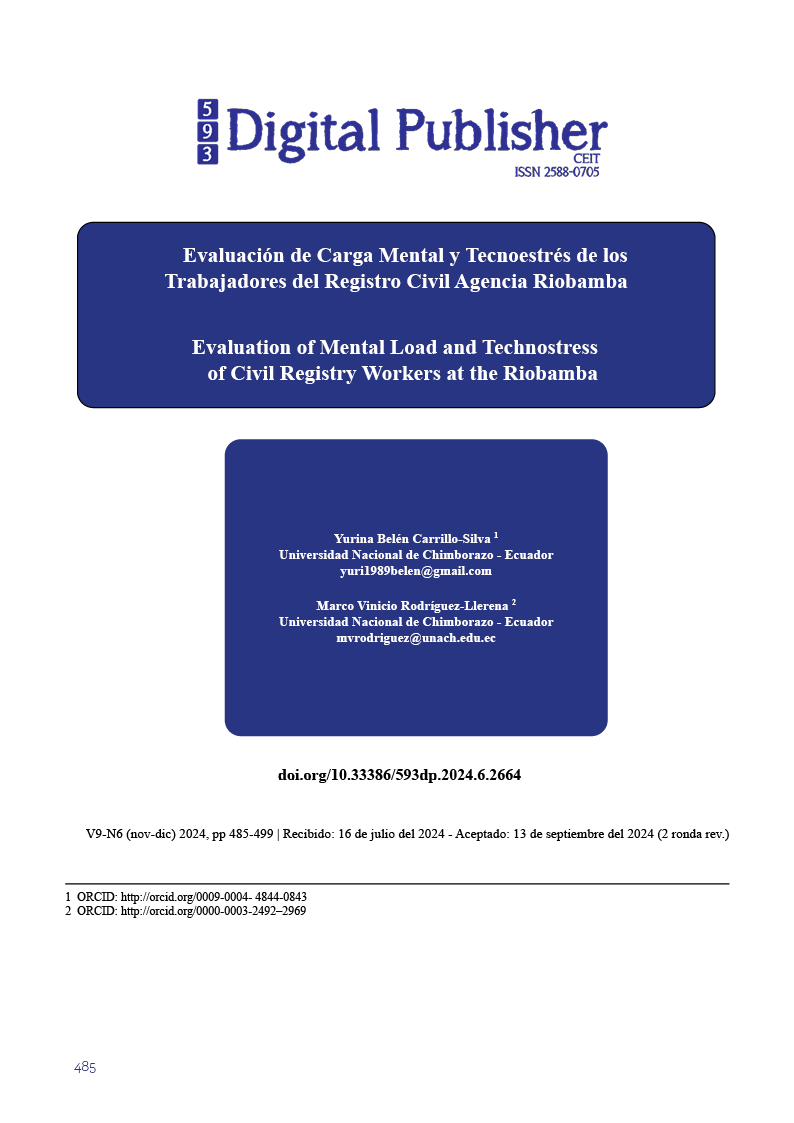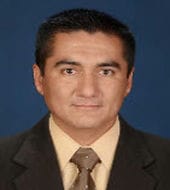Evaluation of Mental Load and Technostress of Civil Registry Workers at the Riobamba Agency
Main Article Content
Abstract
This research work was carried out in the civil registry of Riobamba, focusing on two key aspects: (a) mental load and (b) technostress, assessed at a single time. The objective was to determine the relationship between the levels of mental load and technostress in workers. A correlational approach was applied, using Cramer's V test to analyze how these variables relate to sociodemographic factors. The population consisted of 46 workers, who answered a survey voluntarily through Google Forms. The data collected were organized in Excel and analyzed with SPSS V26. To assess mental load and technostress, the SWAT test and the NTP 730 standard were applied, respectively, both with Likert scales to calculate the final scores. The results show that 6.5% have a low mental load, 87% a medium mental load and 6.5% a high mental load. These results indicate that the predominant mental load is medium-high, which is due to the nature of the organization, especially because it serves clients with a diversity of processes, short deadlines and a large number of people who require the service. Regarding technostress, 73.9% is low, 19.6% medium and 6.5% high. The correlation of variables is established through Cramer's V of the sociodemographic variables and the tests applied. The analysis of the results reveals that, in general, the workers of the Riobamba civil registry face a medium-high mental load and a low level of technostress. These findings show the need to implement a prevention manual to mitigate the negative effects that mental load and technostress can have on the physical and mental health of the staff.
Downloads
Article Details

This work is licensed under a Creative Commons Attribution-NonCommercial-ShareAlike 4.0 International License.
1. Derechos de autor
Las obras que se publican en 593 Digital Publisher CEIT están sujetas a los siguientes términos:
1.1. 593 Digital Publisher CEIT, conserva los derechos patrimoniales (copyright) de las obras publicadas, favorece y permite la reutilización de las mismas bajo la licencia Licencia Creative Commons 4.0 de Reconocimiento-NoComercial-CompartirIgual 4.0, por lo cual se pueden copiar, usar, difundir, transmitir y exponer públicamente, siempre que:
1.1.a. Se cite la autoría y fuente original de su publicación (revista, editorial, URL).
1.1.b. No se usen para fines comerciales u onerosos.
1.1.c. Se mencione la existencia y especificaciones de esta licencia de uso.
References
Acosta, J. (2022). Análisis del comportamiento de indicadores relacionados con la carga mental en estudiantes de Ingeniería Industrial de la Universidad de Matanzas. In [Tesis Posgrado], Universidad de Matanzas. https://rein.umcc.cu/bitstream/handle/123456789/2323/TM22 Juan Lázaro.pdf?sequence=1&isAllowed=y
Almudéver, L., & Pérez, I. (2019). La carga mental de los profesionales de Enfermería en relación con su turno laboral. Ene, 13(1), 1–23. https://scielo.isciii.es/pdf/ene/v13n1/1988-348X-ene-13-01-e1315.pdf
Boyer, D. (2018). The relationship between technology stress and leadership style: An empirical investigation. Journal of Business and Educational Leadership, 8(1), 48–65. https://www.researchgate.net/profile/Sue-Joiner/publication/364639473_An_Analysis_of_Expected_Potential_Returns_Form_Selected_Pizza_Franchises/links/635432db6e0d367d91b71433/An-Analysis-of-Expected-Potential-Returns-Form-Selected-Pizza-Franchises.pdf#page
Cabezas, E., Molina, F., Delgado, J., & Salazar, M. (2023). Visual Fatigue and Technostress in AgroIndustries Standards: Case Study. NeuroQuantology, 21(2), 600–615. https://doi.org/10.48047/NQ.2023.21.2.NQ23063
Cardenas, A., & Bracho, D. (2020). El Tecnoestrés: Una consecuencia de la inclusión de las TIC en el trabajo. Cienciamatria, 6(1), 295–314. https://doi.org/10.35381/cm.v6i1.308
Carrillo, P., Barajas, K., Sánchez, I., & Rangel, M. (2018). Trastornos del sueño: ¿qué son y cuáles son sus consecuencias? Revista de La Facultad de Medicina (México), 61(1), 6–20. https://www.scielo.org.mx/scielo.php?script=sci_arttext&pid=S0026-17422018000100006
Chavarría, A., Cifuentes, C., & Castro, J. (2023). Explicación de la Satisfacción Laboral Mediante el Estrés Laboral , Tecnoestrés y los Riesgos Psicosociales. In [Tesis Doctoral], Universidad Gabriela Mistral. https://repositorio.ugm.cl/bitstream/handle/20.500.12743/2282/ME.PSI %281%29 2023.pdf?sequence=1&isAllowed=y
Cobiellas, L., & Hernández, A. (2020). Estrés académico y depresión mental en estudiantes de primer año de medicina. Educación Médica Superior, 34(2), 1–12. http://scielo.sld.cu/scielo.php?pid=S0864-21412020000200015&script=sci_arttext&tlng=pt
Gavilanes, J., & Moreta, R. (2020). Satisfacción laboral, salud mental y burnout. Análisis de mediación parcial en una muestra de conductores del Ecuador. Psicodebate, 20(2), 7–19. https://doi.org/10.18682/pd.v20i2.1875
Igartua, M. (2020). La Obligación de Seguridad 4.0. Temas Laborales, 151, 327–342. https://dialnet.unirioja.es/servlet/articulo?codigo=7464157
Llorens, S., Cifre, E., & Nogareda, C. (2017). NTP 730: Tecnoestrés: concepto, medida e intervención psicosocial. 1–7.
Martín Rodriguez, O. (2020). El tecnoestrés como factor de riesgo para la seguridad y salud del trabajador. Lan Harremanak - Revista de Relaciones Laborales, 44, 164–183. https://doi.org/10.1387/lan-harremanak.22239
OMS. (2017). Protección de la salud de los trabajadores. Protección de La Salud de Los Trabajadores. https://www.who.int/es/news-room/fact-sheets/detail/protecting-workers’-health
OMS. (2021). La salud mental en el trabajo. La Salud Mental En El Trabajo. https://www.who.int/es/news-room/fact-sheets/detail/mental-health-at-work?gad_source=1&gclid=CjwKCAjwtNi0BhA1EiwAWZaANKQSt_QL7UMjLlx2e9Ja7L3pQTkdw6s8hzyue_hgaZ3Rzfe8OKLv4RoCvmkQAvD_BwE
Ormaza, M., Zambrano, A., Zamora, S., Parra, C., & Félix, M. (2019). Carga mental de profesores de la Escuela Superior Politécnica Agropecuaria de Manabí. Ingeniería Industrial, 40(1), 3–13. http://scielo.sld.cu/scielo.php?script=sci_arttext&pid=S1815-59362019000100003&lang=pt
Quiñones, D., Beltrán, K., & Matabanchoy, S. (2022). Factores de riesgo psicosocial en trabajadores de una empresa del sector eléctrico en el pacífico colombiano. Revista Colombiana de Salud Ocupacional, 12(1), 1–10. https://doi.org/10.18041/2322-634x/rcso.1.2022.7898
Quiroz, E., Ortiz, V., & Villavicencio, E. (2023). Tecnoestrés y tecnoadicción: el papel de la tecnodependencia en trabajadores de Colombia y México. Salud Uninorte, 39(2), 347–363. https://doi.org/10.14482/sun.39.02.020.359
Rolo, G., Díaz, D., & Hernández, E. (2009). Desarrollo de una Escala Subjetiva de Carga Mental de Trabajo (ESCAM). Revista de Psicología Del Trabajo y de Las Organizaciones, 25(1), 29–37. https://scielo.isciii.es/scielo.php?script=sci_arttext&pid=S1576-59622009000100004
Rubio, S., López, M., López, R., & Díaz, E. (2017). Development of the CarMen-Q Questionnaire for mental workload assessment. Psicothema, 29(4), 570–576. https://doi.org/10.7334/psicothema2017.151
Rubio, S., & Rodrigo, I. (2017). Fuentes de carga mental en una muestra de enfermeros y técnicos auxiliares de enfermería de Madrid (España). Revista Iberoamericana de Diagnóstico y Evaluación-e Avaliação Psicológica, 1(43), 177–185. https://www.redalyc.org/journal/4596/459653371014/html/
Sarabia, C., & Cabezas, E. (2024). Evaluación del tecnoestrés en trabajadores del área administrativa del consorcio aero-suspendido de Guayaquil Evaluation of technostress in administrative workers of the consorcio Guayaquil aero-suspended. Technology Rain Journal, 3(2), 1–14.
Soto, K., & Torrin, N. (2023). Propiedades psicométricas de la escala subjetiva de carga mental de trabajo en personal subalterno de una institución militar Peruana. In [Tesis Pregrado], Universidad de Matanzas. https://repositorio.umch.edu.pe/bitstream/handle/20.500.14231/3660/131. Soto y TorrinTesis licenciatura Psicología.pdf?sequence=1&isAllowed=y
Tellez, C., & Tellez, C. (2022). Retos de la salud mental para la cuarta revolución industrial en las empresas de Colombia. Tendencias, 23(2), 332–358. https://doi.org/10.22267/rtend.222302.211
Virla, Q. (2010). Confiabilidad y coeficiente Alpha de Cronbach. Telos, 12(2), 248–252. https://doi.org/10.1109/igarss.2004.1370608



